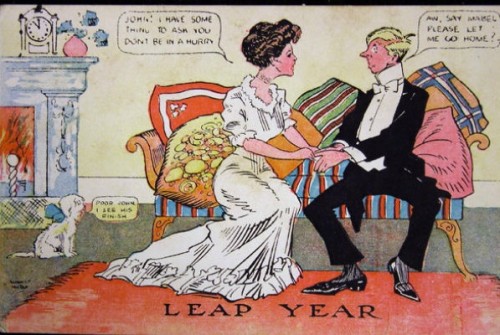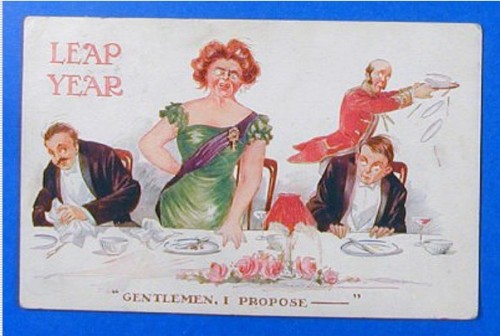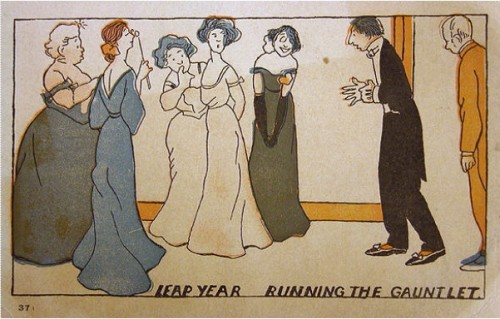It’s a Leap Year for those using the Gregorian calendar, noteworthy because we get an extra day in February to correct the slight difference between our calendar year (365 days) and the actual amount of time it takes the Earth to revolve around the sun once (365 days, 5 hours, 48 minutes, and 46 seconds). Over the last few days I’ve heard several news stories about the Leap Day tradition of gender norms being inverted, so that women are able to ask out or propose to men. I was either entirely unaware of this or perhaps I learn it and promptly forget it every four years, but Laura E. sent in a link to a set of vintage postcards posted at Slate that illustrate the existence of this idea in the early 1900s. The postcards present this upending of the accepted gender script as a terrifying situation for men, who become prey to suddenly emboldened husband-hunters:
“John! I have some thing to ask you. Don’t be in a hurry.”
“Ah, say Mabel, please let me go home?”
The dog: “Poor John. I see his finish.”
In a recently-published article on this tradition, Katherine Parkin points out that women in such postcards are often presented as larger, brawnier, and more aggressive than their poor male prey; the women empowered to ask men to marry them are inherently unfeminine:
For more on portrayals of gendered dating/proposal norms and the Leap Year exception, see the full Slate slideshow and Parkin’s article. Now excuse me, I’m going to go see about ambushing myself a husband.
[Full cite: Katherine Parkin. 2012. “Glittering Mockery: Twentieth-Century Leap Year Marriage Proposals.” Journal of Family History 37(1): 85-104.





Comments 14
MPB — February 29, 2012
see also the movie Leap Year (2010) an entire romantic comedy from built around this "crazy" notion of women proposing
Ricky — February 29, 2012
" Now excuse me, I’m going to go see about ambushing myself a husband."
Oh Gwen, I thought you would never ask!
Pavlov's Cat — February 29, 2012
I love how it's one day every four years. Because otherwise women would be proposing to men left right and centre, amirite? It'd be anarchy.
Tess — February 29, 2012
My favorite part is how if the fella refuses he has to pay a fine or give her a dress or some gloves (depending on which country they're in).
Emma — March 1, 2012
What really stands out to me about these is the clear fear these men have of not being able to choose their courters - as if women should have any sympathy.
Ben — March 1, 2012
My friend (male) was actually just proposed to like this. When he was calling people to let them know, literally no one believed him when he said he was proposed to. (he's young as well, so there's a couple sources of surprise.)
Basiorana — March 1, 2012
My grandmother proposed to my grandfather on leap day in 1948, about five months before he proposed to her. Because these proposals were traditionally seen as a cute little joke, not serious proposals. My grandmother said all her girlfriends would do it but that she had never heard of an actual marriage resulting from those proposals and it was still very much expected that the man would propose later on if they were actually to be wed. She says it was at best a way for women to force their partners to make a decision-- by proposing, their partner would either "accept" which meant that he was thinking along the lines of proposing eventually, or run and hide, and then she would know to break it off because he wasn't serious about the relationship. Most of the time, though, it was a joke.
She also noted that everyone did it, and actually you'd be more likely to do it if you were young, pretty, and likely to be proposed to soon anyway-- you would never try this on a guy you were not very serious about unless you had been drinking because you were seen as pushy or low-class.
Charl076 — March 2, 2012
I'm here today because Mom had the courage to propose to Dad.
Prijestupna godina, rod i obrnuta mogućnost zaruka » Centar za društveno-humanistička istraživanja — March 10, 2012
[...] Gwen Sharp na stranicama thesocietypages.org osvrnula se na prijestupnu godinu i tradiciju koja govori kako žene imaju „dozvolu“ zaprositi [...]
neha — July 23, 2021
I always wanted to learn more about windows 10 OS file explorer and for that this weblog support me find file explorer windows 10 very nicely and solved my all problems easily.
asahi — June 3, 2023
birbirinden eglenceli basket oyunlarini hic zaman kaybetmeden denemek icin simdi baskerbol oyna